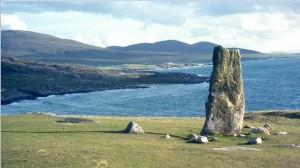 I’m honored to be blogging for Here Women Talk. My latest book, Spirit Stones, Unraveling the Megalithic Mysteries of Western Europe’s Prehistoric Monuments, is my fourth published book and my first book of traditional non-fiction. It was published last October by Five Star Publications.
I’m honored to be blogging for Here Women Talk. My latest book, Spirit Stones, Unraveling the Megalithic Mysteries of Western Europe’s Prehistoric Monuments, is my fourth published book and my first book of traditional non-fiction. It was published last October by Five Star Publications.
When people think of the prehistoric stone monuments of Western Europe, if they think of them at all, of course, they usually think of Stonehenge, the best known example of this ancient architecture, and the focus of a huge prehistoric complex on the Salisbury Plain in the south of England. But there are literally thousands of other sites, from Newgrange, the massive restored burial chamber in Ireland’s Boyne Valley, and large stone circles like Long Meg and Her Daughters and Swinside, both in England’s Lake District, to smaller sites like Dunbeg Stone Circle near Cork, Ireland, Barpa Langais, a remote burial chamber in the Outer Hebrides of Scotland, and single standing stones like the Rudston Monolith in the churchyard of Rudston Parish church in Yorkshire. There are over nine hundred stone circles in Great Britain alone and Western France’s Brittany has thousands of single standing stones.
Almost every megalithic site has a “personality,” depending on its physical situation and surroundings, its form and color, even the time of day or the season. Over the years, European friends have arranged for various stone “hunts” on my visits. And sometimes circumstances or some singular event has added to their wonder and awe, making them truly magical places.
Some years ago, for example, my husband, Dan, and I spent a couple of weeks on the Isle of Lewis in the Outer Hebrides. The MacLeod Stone (Clach Mhicleoid) probably marks a primary landfall in a vast expanse of silver sea, black isles and rugged inlets. Traigh Lar Beach lies just below. As we approached the stone, rising up tall and stately from the moorland grasses, bracken and heather of the coastal hillock on which it stood, a large brown hare, sheltered in the lee of the stone, sprang up and bounded away down the further slope of the hillside. It might have been an earth spirit, some physical remnant connection to the ancient people who raised the monolith so long ago.
I have been drawn to the megalithic architecture of Western Europe since I took my first trip to the British Isles with my brother in the late 1980s. We began our trip in London, driving out to Cornwall where there are numerous prehistoric sites, among them the burial chamber of Chun Quoit and the Merry Maids Stones Circle, but Castlerigg, was a particularly special experience. Not only is it one of the most beautifully situated of Britain’s stone circles, in a meadow surrounded by the highlands of the Lake District, but I was taken with the aesthetics of the circle itself in terms of pure artistry, the shapes of the stones, the colors and types of rock used and so forth, but also with a powerful sense of a distant Neolithic and Bronze Age past. I could almost feel the concrete presence of those bygone times.
Over the years then, I continued to add to my collection of stone experiences, photographic and otherwise, and I began to think that I could honor these stones in some way by telling their story, by focusing on the power of the stones themselves, uncovering ways in which they might capture our spiritual imagination. There are many lessons that can be learned from prehistoric monuments, one of the most prominent being the wonder of life itself. The aesthetics and the often stunning natural settings of these stones bring that to mind, the simple appreciation of life’s bounty and beauty, a recognition of the oneness of life and the continuity of the human experience through time. This, I feel, leads us to a greater tolerance and appreciation of others in our world, both human and non-human, and of our world itself.
My ultimate aim in Spirit Stones was to link the form and surmised functions of megalithic architecture to our present day search for spiritual insight; to connect the long ago and the far away with the here and now. We are each the product of a boundless past. Stone monuments, as part of that past, can renew our sense of the mystery and wonder of life, of the great gift of being and the continuity of the human spirit.
– Dianne Ebertt Beeaff
Editor’s Note: Dianne was a guest on HereWomenTalk.com radio along with Shaman Medicine Woman Carla Goddard and Jessamine Dana, Woman and the Owl Project. You can listen to our “SOULversation” here.

